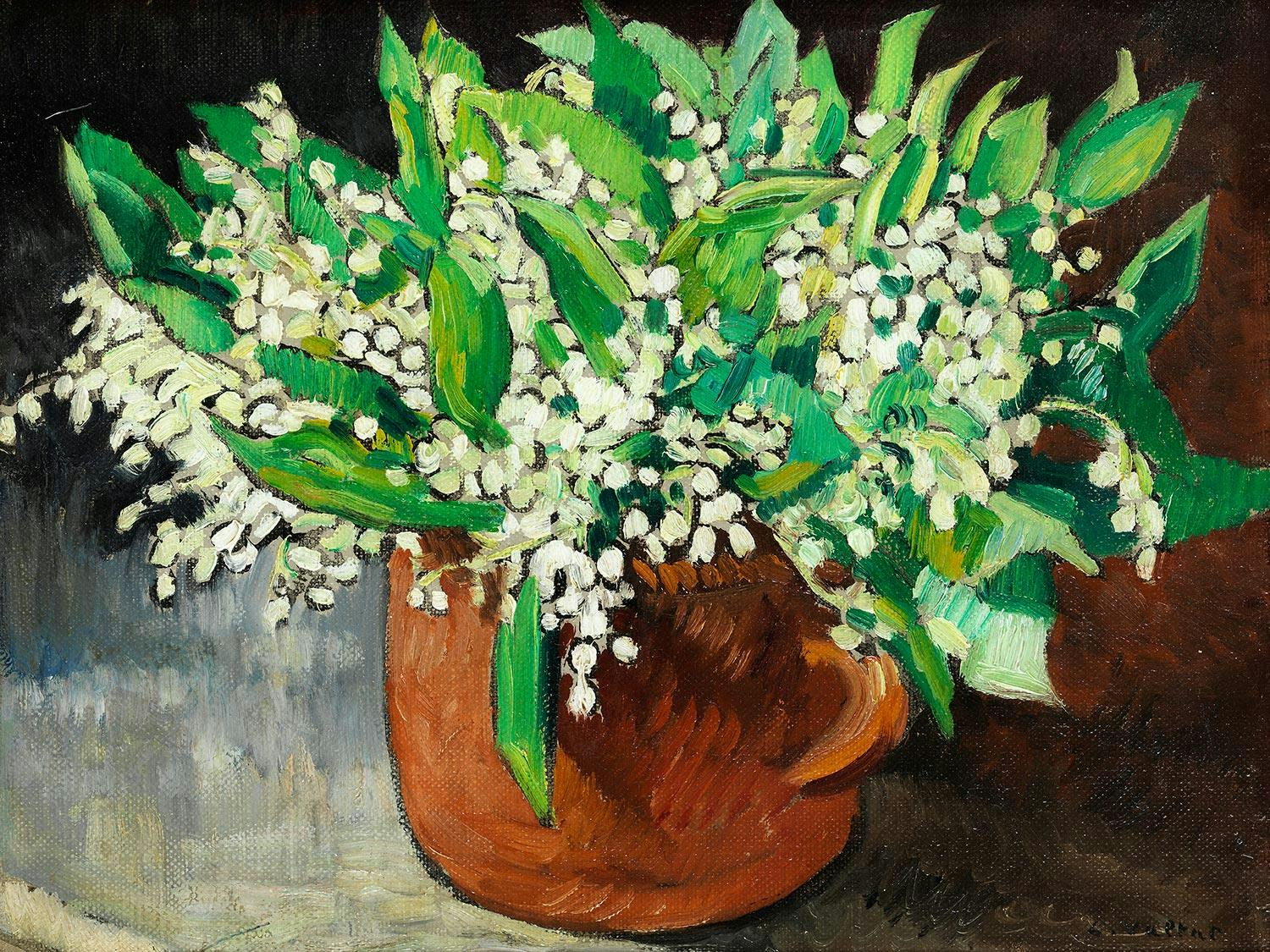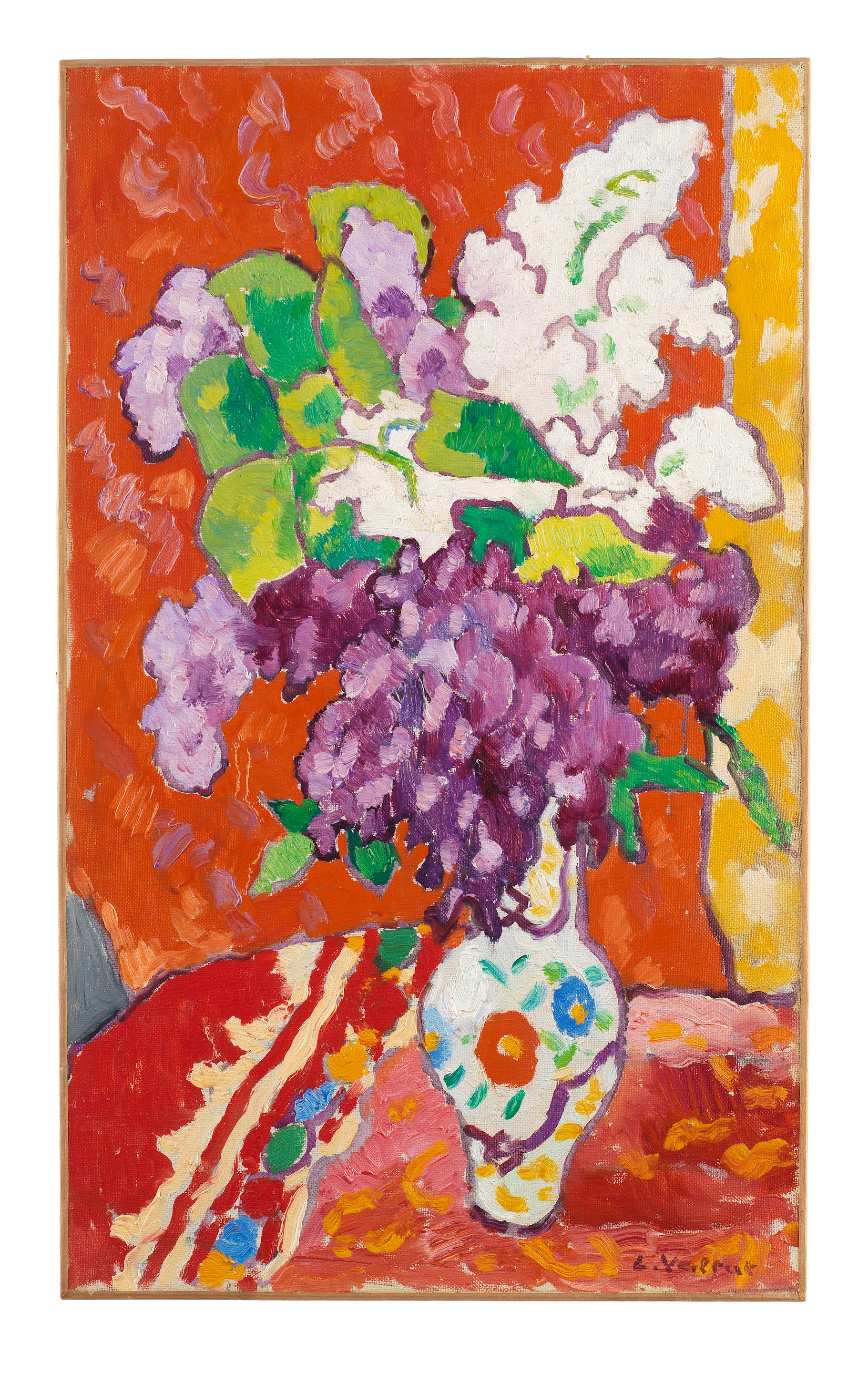LOUIS VALTAT France 1869-1952 Vase de fleurs Executed around 1905 Signed. Oil on board laid down on panel. 33,6 x 26 cm PROVENANCE Greta Garbo collection, New York. Sotheby's 15 November 1990, The Greta Garbo Collection, catakigue number 29, illustrated in colour on full page. Photo certificate from the artist's grandson Louis-André Valtat, dated 8 November 2004, is supplied. Archive L-A Valtat no. 3201. Greta Garbo suddenly retired from her peaking Hollywood career for a quiet life far away from the spot lights. The withdrawal from the public eye added to her mysterious persona and has immortalized her as cinema's greatest icons. She left Los Angeles and moved to New York, which became her home for the rest of her life. She loved her Manhattan apartment and it held one of her big interests ; her art collection. Her taste was refined yet personal with a penchant for early twentieth-century modernism and flower paintings. Our painting by Louis Valtat ((1869-1952) hung in Greta Garbo's L-shaped drawing room and she had it placed next to paintings by Kees van Dongen and Georges d' Espagnat She frequently visited art exhibitions and galleries and she acquired her art in New York and during her travels in Europe. Louis Valtat's strident colors and wild brush work where fascinating. His style was influenced by Van Gogh and he is considered one of the key artists of the Fauvism of the early 1900s. Louis Valtat (1869-1952) was born straight into the modern era in the very heart of Western culture at that point; France. Valtat's father who was an amateur painter gave his son training from an early age and with the school years in Versaille, he had close access to the vivid art scene in close-by Paris. As a seventeen year old, he joined the prestigious École des Beaux- Arts in Paris and completed his studies at the Académie Julian, which he attended together with artists such as Pierre Bonnard and Edouard Vuillard Only in his mere twenties he received the critic's acclamations for his paintings of urban city life, and in 1890 he won the Jauvin d' Attainville Prize, and he established his own studio at the rue La Glaciere. Three years later he debuted at the Salon des Indépendants with works that incorporated both Impressionistic light study as well as the characteristic dot painting of Pointilism. The experiments with colour became principle to Valtat and he joined the circle around Henri Matisse and André Derain Under the rallying cry "liberation of paint" these artists emphasized the intrinsic value of colour and they often used pure colours, straight from the paint tube. A critical event occurrred when Auguste Renoir introduced Valtat for the legendary art dealer Ambroise Voillard. Together, they made an arrangement where Voillard purchased practically speaking all Valtat's work for the next ten years. Valtat's major breakthrough occurred in connection with his participation in the Fauvist exhibition at the Salon d' Automne in 1905 where his work was published in the magazine L' Illustration next to artworks of Henri Manguin, Henri Matisse André Derain and Jean Puy While most Fauvists abandoned the style after a few years Valtat continued his coloristic experiments for the rest of his life. He suffered from tuberculosis and therefor spent much of his time away from the city; in the South of France or in the valley of Chevreuse near Paris, and his motives primarily focused on landscapes, still lifes and flowers. The last years of his life he became blind and his last public appearance was at the great Fauvist exhibition of the summer of 1951 at the Musée National d'Art Moderne in Paris where he acclaimed the status as one of the central figures of the style. Greta Garbo was an active art collector, and she was very well-informed. She continuously built on to the art collection and she enjoyed it throughout her life. When she passed away in 1990 her sole heir, the grand-niece Grey Horan inherited the entire estate including the
LOUIS VALTAT France 1869-1952 Vase de fleurs Executed around 1905 Signed. Oil on board laid down on panel. 33,6 x 26 cm PROVENANCE Greta Garbo collection, New York. Sotheby's 15 November 1990, The Greta Garbo Collection, catakigue number 29, illustrated in colour on full page. Photo certificate from the artist's grandson Louis-André Valtat, dated 8 November 2004, is supplied. Archive L-A Valtat no. 3201. Greta Garbo suddenly retired from her peaking Hollywood career for a quiet life far away from the spot lights. The withdrawal from the public eye added to her mysterious persona and has immortalized her as cinema's greatest icons. She left Los Angeles and moved to New York, which became her home for the rest of her life. She loved her Manhattan apartment and it held one of her big interests ; her art collection. Her taste was refined yet personal with a penchant for early twentieth-century modernism and flower paintings. Our painting by Louis Valtat ((1869-1952) hung in Greta Garbo's L-shaped drawing room and she had it placed next to paintings by Kees van Dongen and Georges d' Espagnat She frequently visited art exhibitions and galleries and she acquired her art in New York and during her travels in Europe. Louis Valtat's strident colors and wild brush work where fascinating. His style was influenced by Van Gogh and he is considered one of the key artists of the Fauvism of the early 1900s. Louis Valtat (1869-1952) was born straight into the modern era in the very heart of Western culture at that point; France. Valtat's father who was an amateur painter gave his son training from an early age and with the school years in Versaille, he had close access to the vivid art scene in close-by Paris. As a seventeen year old, he joined the prestigious École des Beaux- Arts in Paris and completed his studies at the Académie Julian, which he attended together with artists such as Pierre Bonnard and Edouard Vuillard Only in his mere twenties he received the critic's acclamations for his paintings of urban city life, and in 1890 he won the Jauvin d' Attainville Prize, and he established his own studio at the rue La Glaciere. Three years later he debuted at the Salon des Indépendants with works that incorporated both Impressionistic light study as well as the characteristic dot painting of Pointilism. The experiments with colour became principle to Valtat and he joined the circle around Henri Matisse and André Derain Under the rallying cry "liberation of paint" these artists emphasized the intrinsic value of colour and they often used pure colours, straight from the paint tube. A critical event occurrred when Auguste Renoir introduced Valtat for the legendary art dealer Ambroise Voillard. Together, they made an arrangement where Voillard purchased practically speaking all Valtat's work for the next ten years. Valtat's major breakthrough occurred in connection with his participation in the Fauvist exhibition at the Salon d' Automne in 1905 where his work was published in the magazine L' Illustration next to artworks of Henri Manguin, Henri Matisse André Derain and Jean Puy While most Fauvists abandoned the style after a few years Valtat continued his coloristic experiments for the rest of his life. He suffered from tuberculosis and therefor spent much of his time away from the city; in the South of France or in the valley of Chevreuse near Paris, and his motives primarily focused on landscapes, still lifes and flowers. The last years of his life he became blind and his last public appearance was at the great Fauvist exhibition of the summer of 1951 at the Musée National d'Art Moderne in Paris where he acclaimed the status as one of the central figures of the style. Greta Garbo was an active art collector, and she was very well-informed. She continuously built on to the art collection and she enjoyed it throughout her life. When she passed away in 1990 her sole heir, the grand-niece Grey Horan inherited the entire estate including the















Testen Sie LotSearch und seine Premium-Features 7 Tage - ohne Kosten!
Lassen Sie sich automatisch über neue Objekte in kommenden Auktionen benachrichtigen.
Suchauftrag anlegen